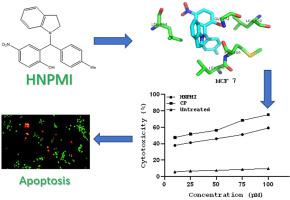European Journal of Pharmacology ( IF 4.2 ) Pub Date : 2020-05-21 , DOI: 10.1016/j.ejphar.2020.173195 Suresh Palanivel 1 , Akshaya Murugesan 2 , Kumar Subramanian 3 , Olli Yli-Harja 4 , Meenakshisundaram Kandhavelu 1

|
Indoline derivatives functions as an inhibitors of epidermal growth factor receptor (EGFR) with the anticancer potential against various cancers. We aim to investigate anti-breast cancer effects and mechanism of action of novel indoline derivatives. Molecular docking of seven indoline derivates with EGFR revealed, N-(2-hydroxy-5-nitrophenyl (4′-methylphenyl) methyl) indoline (HNPMI) as the top lead compound. RT-PCR analysis showed the downregulation of PI3K/S6K1 genes in breast cancer cells through the activation of EGFR with HNPMI. This compound found to have higher cytotoxicity than Cyclophosphamide, with the IC50 of 64.10 μM in MCF-7 and 119.99 μM in SkBr3 cells. HNPMI significantly reduced the cell proliferation of MCF-7 and SkBr3 cells, without affecting non-cancerous cells, H9C2. Induction of apoptosis was analyzed by Caspase-3 and -9, DNA fragmentation, AO/EtBr staining and flow cytometry assays. A fold change of 0.218- and 0.098- for caspase-3 and 0.478- and 0.269- for caspase-9 in MCF7 and SkBr3 cells was observed, respectively. Caspase mediated apoptosis caused DNA fragmentation in breast cancer cells upon HNPMI treatment. The structural elucidation of HNPMI by QSAR model and ADME-Tox suggests, a bi-molecular interaction of HNPMI-EGFR which is related to antiproliferative and apoptotic activity. The data concludes that, HNPMI-induced the apoptosis via EGFR signaling pathway in breast cancer cells. Thus, HNPMI might serve as a scaffold for developing a potential anti-breast cancer therapeutic agent.
中文翻译:

吲哚衍生物N-(2-羟基-5-硝基苯基(4'-甲基苯基)甲基)吲哚啉在乳腺癌细胞中的抗增殖和凋亡作用。
吲哚啉衍生物用作表皮生长因子受体(EGFR)的抑制剂,具有抗多种癌症的潜力。我们旨在研究抗乳腺癌作用和新型吲哚啉衍生物的作用机理。七种二氢吲哚衍生物与EGFR的分子对接显示,N-(2-羟基-5-硝基苯基(4'-甲基苯基)甲基)吲哚啉(HNPMI)是最主要的先导化合物。RT-PCR分析显示,通过HNPMI激活EGFR,乳腺癌细胞中PI3K / S6K1基因下调。发现该化合物的细胞毒性比环磷酰胺高,IC 50在MCF-7中为64.10μM,在SkBr3细胞中为119.99μM。HNPMI显着降低了MCF-7和SkBr3细胞的细胞增殖,却不影响非癌细胞H9C2。通过Caspase-3和-9,DNA片段化,AO / EtBr染色和流式细胞术分析了凋亡的诱导。在MCF7和SkBr3细胞中,caspase-3的倍数变化分别为0.218-和0.098-,caspase-9的倍数变化为0.478-和0.269-。半胱天冬酶介导的细胞凋亡在HNPMI治疗后导致乳腺癌细胞DNA断裂。通过QSAR模型和ADME-Tox对HNPMI的结构解析表明,HNPMI-EGFR的双分子相互作用与抗增殖和凋亡活性有关。数据得出的结论是,HNPMI通过EGFR信号通路诱导乳腺癌细胞凋亡。从而,


















































 京公网安备 11010802027423号
京公网安备 11010802027423号